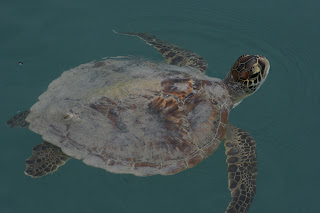Saturday 13th October: Monkey Mia – Hamelin Pool 424km Wendy lead
We were woken before dawn with vehicles leaving very early, possibly to go fishing. Got up at dawn and wandered down to the beach. Not a breath of wind, water as smooth as glass and within 50 meters of shore we watched 4 dolphins feeding and a stingray glide by within a meter of shore. After breakfast we broke camp and waited for the dolphin interaction display the resort puts on each morning, although it’s up to the dolphins if they decide to turn up or not. While waiting, a turtle swam past close to shore. With a big day ahead of us we couldn’t wait for the dolphins to appear and as we had already seen them feeding for themselves we left Monkey Mia at 8:30. Back down the Peron Peninsula 100km, hung a right for 40km, then another right.heading north west. The road changing from sealed to wide dirt, to narrow & corrugated and finally single lane and sandy. We came to a hill that was all soft sand, without knowing how long, steep or how many more to follow we aired down and made a run for it. Clawed our way to the top and down the other side. Finally made it to Steep Point – westernmost point of mainland Australia. The return trip wasn’t quite as bad but very thankful that we hadn’t met another vehicle on the track. We made it back fairly late to Hamelin Pool at the base of the Peron Peninsula and stayed at a camp ground the complete opposite to the previous night. Small with few other campers and a very friendly & knowledgeable staff it was a real gem. On arriving we were given a tour of the old telegraph exchange and told a little of the history of the place. The telegraph was established in the 1800’s as a repeater station. Back in those days, before the advent of the telephone, messages were sent by morse code but the power could only transmit a signal 100miles so repeater stations were set up all along the coast. There is an old disused quarry just back from the shoreline for mining shell blocks. Unlike Shell Beach we visited previously where the shells are loose; these shells are cemented together by rain leeching the calcium from the shells and being compacted down under pressure. The deposits are up to 8 meters deep and are cut out using hand saws into blocks which were used for building. Hamelin Bay itself is unique. At its entrance there is a natural sand bank so the tidal movement is restricted to about 300mm. With the pool only about 1,200mm deep, high temperatures and little rain resulting in high evaporation the salinity of the water is 2 ½ times that of the ocean which keeps the sea slugs and snails out – the natural predators of Stromatolites. Now, what are Stromatolites I hear you ask. Quite simply, without them you may not be here. They are, literally, living rocks. Formed in colonies by single-celled microbes growing at only .3mm per year. They’ve been around for 3.5 billion years when there was only 1% oxygen in the atmosphere and as they release oxygen, they were the main contributor of raising the oxygen level to 21% helping create the environment for all other living organisms. It took another billion years for two types of bacteria to merge to form a more complex single-celled organism establishing the building block for the later evolution of higher life forms. Come to think of it, I know a few humans that are very closely related to Stromatolites.
Subscribe to:
Post Comments (Atom)




No comments:
Post a Comment